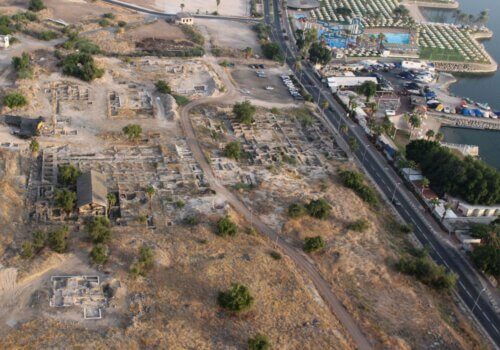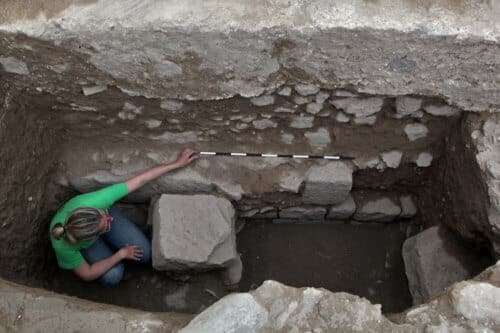This is a large mosque from the early Muslim period, when Tiberias was a local district capital. But the great story of the building lies beneath it - since the beginning of the excavations in 2009, the researcher realized that inside the ground are the remains of an earlier mosque, probably from the second half of the 7th century AD, which makes it the oldest mosque that has been archaeologically uncovered so far in the whole world

The renewed excavation project in Tiberias under the management of Dr. Katia Tzitrin-Salberman from the Institute of Archeology and the Department of Islamic and Zoological Studies at the Hebrew University, a researcher who specializes in the archeology of the Islamic period and, among other things, religious buildings, has yielded fascinating discoveries over the years, but one of them continues to occupy Dr. Tzitrin -Salberman and other researchers to this day - re-identification of a structure whose initial disclosure in 1952 was partial and became a real mystery over the years. Initially, the building was considered a covered market from the Byzantine period, but in light of comparisons with other sites, it became clear that it is a religious building of historical significance. In recent years, Dr. Citrin-Salberman has been able to prove that this is a large mosque from the early Muslim period, when Tiberias was the capital of a local district. But the great story of the building lies beneath it - since the beginning of the excavations in 2009, the researcher realized that inside the ground are the remains of an earlier mosque, probably from the second half of the 7th century AD, which makes it the oldest mosque that has been archaeologically uncovered so far in the whole world .
"In fact, until recently they did not understand at all that these were parts of an ancient mosque, or of a mosque in general. In scientific journals I mentioned the discovery briefly, but no article to date has written in detail about this fascinating discovery. Although I am currently not excavating it, and am focusing on other areas of the site, I have discovered some intriguing things about this mosque in recent times. For example, from the correspondence I conducted with an archaeologist from Yemen, I received reinforcement for my hypothesis that the construction technology used in the ancient mosque, simple and pragmatic that does not characterize the region, probably entered Israel starting with the Arab occupation in the seventh century AD. It is possible that this is a technology that originates from the Arabian Peninsula," explains Dr. Tzitrin-Salberman.
The researcher also claims regarding the lower mosque that was found that "it is worth noting that we know through the sources about many ancient mosques in Israel and in the world that were founded at the beginning of Islam, only that today it is not possible to excavate them because most of them are under active mosques. In Tiberias we had a rare opportunity to excavate the site and explore, in fact, an ancient mosque beneath a partially surviving mosque. By the way, the oldest mosque uncovered so far was the one in Basit, Iraq (from 703), but it seems to us that the one in Tiberias is several decades earlier, which is amazing in itself."

Only the lower foundations remain of the lower mosque, and through the latest finds discovered in the fill under its floor, it has become clear that it was built in the seventh century AD. Coins and pottery suitable for that period were found in this filling. According to the researcher's estimate, the size of the ancient mosque was about 22 x 49 m, in the shape of an imperfect rectangle. The mosque found is actually Masjid al-Jamaa, a community mosque for gatherings to hear the Friday sermon (khutbah), which is considered the main mosque of the city.
Excavations in Tiberias will soon resume, this time in cooperation between the Hebrew University and the German Institute for Archeology on the Mount of Olives. The municipality of Tiberias, the city's youth and the hotel association expressed their willingness to mobilize for the success of the excavations. Among other things, excavations will be carried out in what appears to be a small church, a 'chapel', from the Crusader period in the 12th century, which was first uncovered in 2018. Not much is known about this church, which was built next to the wall of the abandoned great mosque mentioned above, and not far from the site of the Byzantine church of Tiberias, which also stood in ruins. This ruined church, which operated between the 5th century and at least the 10th century AD, was the largest in the Galilee region (even larger than the monumental church in Zipori), apparently the one that served as the seat of the regional archbishop.
According to the researcher, the various religious buildings found in this area, one next to the other, show on the one hand the multi-religiousness of the city throughout the periods, but also the religious-political power struggles in that place. The researcher believes that for decades the church continued to be the dominant building in the city, along with the synagogue in Hamat Tiberias, until around the 20s of the 8th century, the Muslim regime changed the face of the city by erecting a large mosque building, 78 x 90, which overshadowed the the church. On the other hand, the researcher believes that the relations between the religious groups in Tiberias at that time were relatively good and made it possible to maintain a multi-religious life.
We believe that next to these two buildings also stood a monumental synagogue, among the many that were in Tiberias according to the many sources," the researcher further describes. "In other words, this is an area that was multi-religious and a symbol of a particularly exciting regional coexistence. It is important to mention that while these monumental buildings stood in the center of the city, the period of their activity was considered the peak period of the city. This is the period of the impressive Jewish activity known to all of us, among other things through the biblical text that is dear to everyone - the crown of Aram Zova, dating from the first half of the 10th century AD."
For further reading, a scientific article is attached
More of the topic in Hayadan:
- A cache of molds for oil candles was uncovered in an archaeological dig in Tiberias
- A Jew likes fish? - Chapter three - Tiberias: the capital of the Galilean fishing
- A perfume shop from the ninth century AD was found in Tiberias
- 500 years after the expulsion of the Muslims from Granada, the mosque was opened
